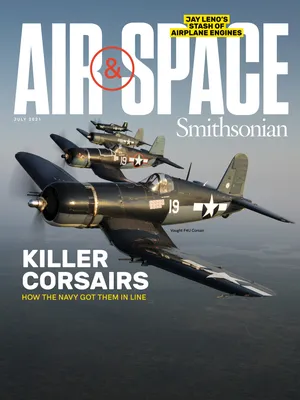Team Spirit on a Supercarrier
Pilots flying from a modern aircraft carrier are not alone. They’re part of a floating city.
:focal(431x123:432x124)/https://tf-cmsv2-smithsonianmag-media.s3.amazonaws.com/filer/98/b7/98b7b318-3e36-471a-8a96-827769f2df71/25b_jj2021_f14andlso_onlincoln_live.jpg)
In this issue, you’ll find the story of the outstanding aviators and innovative engineers who nudged the Vought F4U Corsair fighter into shipshape for carrier service during World War II. It’s an exciting look into a world where the smallest course correction or tiniest “thingamabob” (to borrow a term from the piece) can make a life-saving difference, and it emphasizes the complexity of projecting airpower from the deck of a ship—a process that helped define the modern world in the second half of the 20th century and remains a cornerstone of peace and power in the 21st.
The story of the Corsair’s spoiler also captures some of the visceral emotion of landing an airplane on a ship at sea. I had the privilege of flying F-14 Tomcats on and off carriers during my Navy service in the 1980s. I had wanted to serve my country doing the craziest, most exciting flying I could, and my billet as Naval Flight Officer aboard the USS Dwight D. Eisenhower (informally called “Ike”) definitely fit that bill.
From this story alone, carrier flying may even seem solitary. An experienced aviator can define and overcome many deficiencies in any given airframe. As Lieutenant Commander Porter showed in the Corsair, the machine matters, and the pilot matters more. But a modern, nuclear-powered, Nimitz-class aircraft carrier may carry up to 6,000 sailors. That number includes pilots, technicians, air traffic and deck personnel directly involved in flight operations, but also an entire community that supports that mission—from supply clerks and clergy to doctors and dentists.
Supercarriers are floating cities with a fully functioning airport sitting on top (and living underneath a runway is exactly as loud as you imagine). And that’s before you factor in the full carrier strike group. A carrier is accompanied by cruisers, destroyers, frigates, supply and logistics ships, and even submarines. With replenishment and support, nuclear carriers can stay at sea for years at a time, and there are multiple carrier strike groups circling the globe 24/7/365.
It takes many thousands of dedicated men and women to keep carriers operating to protect the nation’s interests. And nowhere in the world is commitment to a shared mission more evident than in the way the U.S. Navy launches and recovers aircraft—often in harm’s way. I had the good fortune and honor of being a part of that mission, and I recommend it to anyone who wants a career of service with excitement.
Christopher U. Browne is the Acting Director of the National Air and Space Museum.
